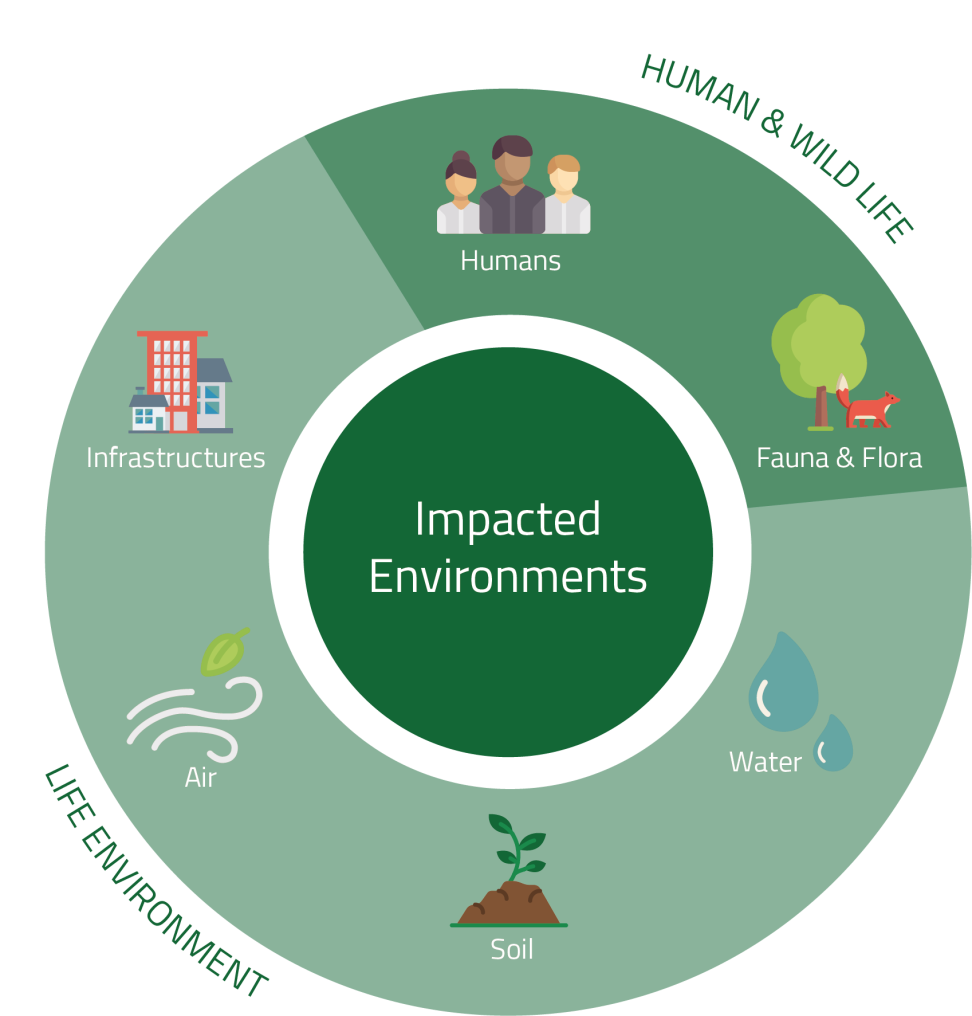What is the environment around a geothermal site?
The environment of a geothermal site includes all elements related to nature (such as air, soils, surface and deep water, fauna and flora), people, and infrastructures, which can be impacted by geothermal operations. The extent of the environmental impacts depends on the geothermal project and is mainly defined by the following parameters:
- Reservoir: resource conditions, presence of gases and hydrocarbons, fluid geochemistry, tectonic stress field, etc.
- Boreholes: completion design, casing integrity, reservoir connection, etc.
- Natural context: proximity of protected natural areas, presence of fresh water aquifer, natural hazards, etc.
- Socio-economic context: population density, land use, nearby infrastructures, etc.
- Project design: single well or doublet, production and reinjection conditions, open or closed production loop, degassing processes, inhibitor applications, etc.
- Operational stage: drilling, stimulation and testing, operations, dismantling, etc.
- Legal framework: laws, regulations, standards.
Why is environmental monitoring important for a geothermal site?
Environmental monitoring is a fundamental tool in order to identify and quantify the spatio-temporal consequences of geothermal exploitation as well as the causes of the observed impacts. Through surface and underground monitoring, the severity and frequency of environmental impacts can be assessed, allowing decision-makers to determine appropriate treatment measures. Furthermore, this monitoring system also evaluates the efficiency of the applied mitigation measures. In that way, one can review and update changes in the environment and the preservation procedures.
How should the environment be monitored?
As mentioned above, the requirements for environmental monitoring vary as a function of the reservoir context, the project design and the operational phase. Thus, depending on the frequency and severity of the observed/expected impacts, the monitoring system should be adapted. Furthermore, it is important to characterize in advance the initial environmental parameters to correctly evaluate the impact of the geothermal exploitation. In general, the following items should be monitored to minimize environmental impacts.
- Ground motion monitoring
Due to pumping and reinjection activity, induced seismicity, slow in-depth and surface deformations (creep, subsidence and uplift) may occur, causing damages on buildings and risking human safety. To monitor those physical processes, a multi-parametric geophysical ground motion network may be designed, including seismological and geodetic measurements.
- Resource monitoring
Monitoring geothermal resource features is a necessary preventive process to anticipate changes of reservoir and/or installation conditions. Monitoring may include the continuous measurement of pressure, temperature and flowrate, but also punctual analysis of the resource’s geochemical parameters (e.g. electrical conductivity, pH, Eh, as well as major and trace elements).
- Waste disposal
Gas, liquid, and solid wastes may be produced during geothermal exploitation and need to be monitored. For gas, continuous or punctual measurements of the plant’s atmosphere and emissions may be required. Liquid waste could be monitored by high-frequency analysis of the basic physico-chemical parameters coupled with occasional analysis of the fluid geochemistry and bacterial activity. For solid wastes, the main concerns include the formation of secondary mineral deposits (silica, carbonates, metals, radioactive material …). The monitoring of those deposits may include geochemical and radioactive characterization, but also in-situ measurements of deposition and corrosion processes by online sensors.
- Underground water monitoring
To avoid groundwater contamination during geothermal exploitation, a network of piezometers equipped with online sensors could continuously monitor peripheral wells to measure the level and the physico-chemical parameters of the water body.
- Surface disturbance
Surface disturbances mainly concern noise and visual impacts. Noise level monitoring during the drilling phase is thus necessary to meet the legal limits. Visual impacts are difficult to monitor but may be mitigated by the installation of visual barriers around the site.
Authors
Reviewer
Peter Meier, Geo-Energie Suisse AG
References
Arauz Torres M.A., 2011. Environmental monitoring of geothermal projects in Nicaragua. Geothermal training programme of the United Nations Univerisyt, Reykjavik (Iceland), 2011.
Gunnlaugsson E., 2003. Environmental monitoring. Geothermal training programme of the United Nations Univerisyt, Reykjavik (Iceland), 2003.
Haraldsson I.G., 2011. Environmental monitoring of geothermal power plants in operation. Short course on geothermal drilling, resource development and power plants, Santa Tecla (El Salvador), 2011.
Peterschmitt A., Hehn R., Bosia C., Cuenot N., Pratiwi A.S. and Genter A., 2018. A comprehensive report on risk assessment and workflow for soft stimulations. Demonstration of soft stimulation treatments of geothermal reservoir project (DESTRESS), Horizon 2020 EU Research and Innovation Program, Deliverable 3.1.
Ravier G., Baujard C., Dalmais E., Maurer V. and Cuenot N., 2016. Towards a comprehensive environmental monitoring of a geothermal power in the Rhine graben. European Geothermal Congress, Strasbourg (France), 2016.




